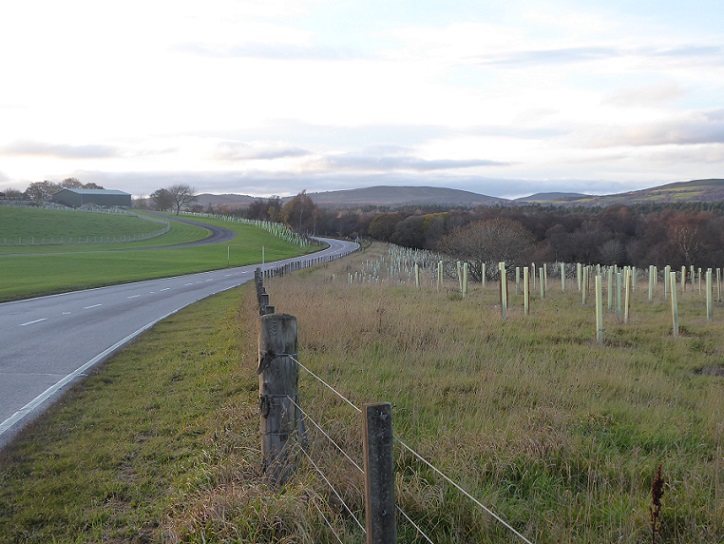
One thing the Cairngorms National Park Authority (CNPA) needs to fix urgently in the new National Park Partnership Plan, which is currently out for consultation, is the plastic tree tube problem (see here).
The case against using plastic in the countryside
I had not driven along the A95 north of Grantown-on-Spey for a number of years but did so a couple of weeks ago and there is now a forest of plastic before you get to Cromdale – all within walking distance of the Cairngorms National Park headquarters.

The tree tubes are just above the River Spey which is designated a Special Area of Conservation to protect four species:
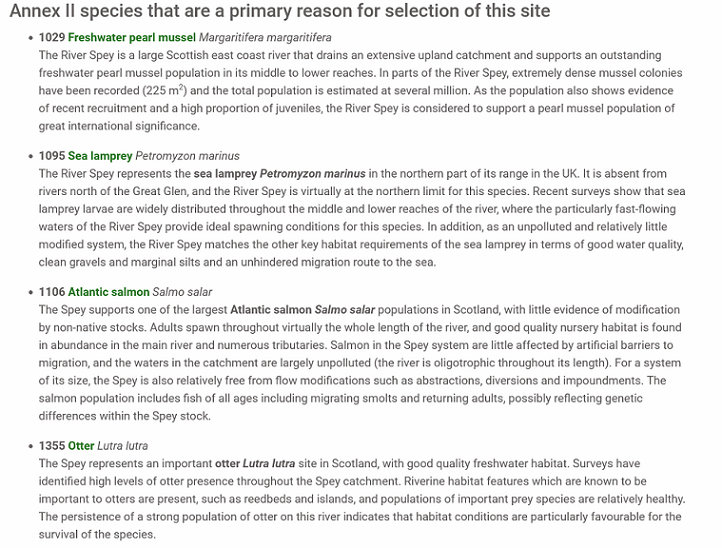
Mussel, lamprey, salmon and otter, all four species will inevitably be affected by the tree tubes.
It works like this. Whether or not arrangements are in place to remove the plastic tree tubes eventually, they will have started breaking down from the moment they were installed. Research on the levels of plastic in bottled drinking water, for example, has suggested that the very act of adding or removing the bottle top may be what releases tiny plastic particles into the water (see here).
The action of the elements, the wind knocking the tubes against the support stakes or animals brushing against them, will do the same; releasing plastic particles and leaching chemicals into the natural environment. Those chemicals and particles will then make their way down into the River Spey where many will be filtered through the gills of the “outstanding” population of freshwater pearl mussels. And so on through the food chain………………..
So why hasn’t NatureScot or the CNPA spoken out? As a country, Scotland appears incapable of applying the precautionary principle even in our National Parks.
Plastic tree tubes and woodland expansion
If the aim was to restore woodland, however, rather than collect public subsidy, the use of plastic tree tubes by the Spey below Grantown and all the others that have been used along the major rivers in the Cairngorms National Park (see here) should have been completely unnecessary.
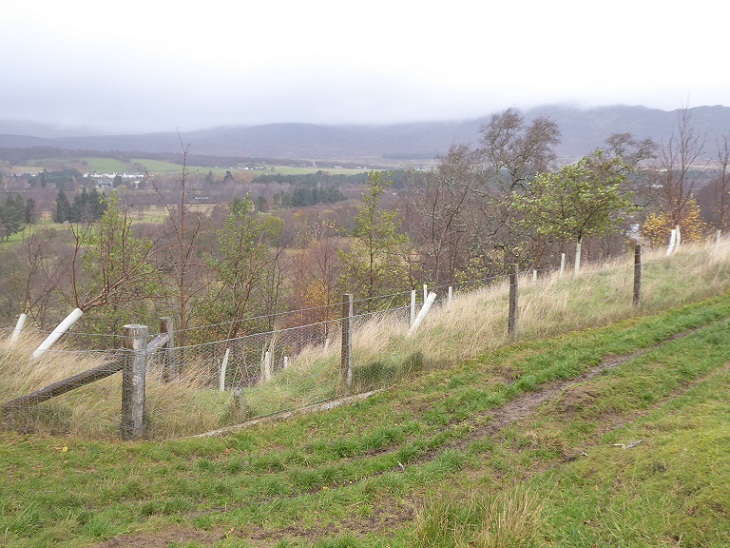
I spotted a perfect example of this a couple of days later, also above the Spey. In one area trees had been planted using tubes when a few hundred metres down the road a small enclosure showed trees growing quite happily without.
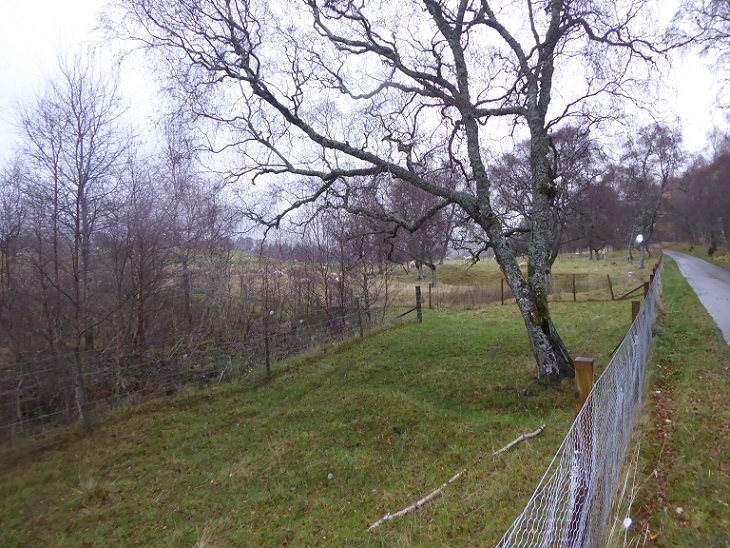
The evidence is obvious, reduce the grazing pressure from larger animals like sheep and deer and the woodland will regenerate naturally without any need for plastic tubes. That still leaves a problem, however, because as long as predators are ruthlessly persecuted, the number of smaller herbivores, voles, rabbits and hares, will be artificially high and they are likely to eat most of the natural regeneration. That problem actually becomes worse when lots of trees are planted all in one go: the abundant new food source leads to a boom in the population of small herbivores. This is then used to justify the use of tree tubes.
The chicken wire fencing in the two photos above perfectly illustrates the problem. The Ralia Estate breeds large numbers of pheasants which they wish to protect against pesky predators like stoat. Stoats are prolific breeders, traps alone haven’t worked, hence why miles of chicken wire fencing are now being installed. But reduce the number of stoat to very low numbers and that also reduces the rate of natural regeneration to very low levels and risks new woodland planting. So, people resort to plastic tree tubes. A vicious circle of environmental destruction.
The CNPA’s National Park Partnership Plan and tree tubes
The draft CNPA National Park Partnership Plan (NPPP) (see here) says nothing directly about tree tubes could offer a way out of this vicious circle. First and most importantly it says that natural regeneration should be the primary means by which woodland should be allowed to expand:

If implemented, this objective would result in the use of plastic tree tubes to enable woodland expansion in the National Park to be greatly reduced. But it could still allow a considerable number of plastic tree tubes to be used where planting does occur. The objective therefore needs to be strengthened and explicitly state that plastic tree tubes should never be used. Moreover, if the CNPA becomes a regional land-use partnership, as is being proposed, and has responsibility for disbursing rural payments in the Cairngorms, it could stop the funding streams that fuel this disaster.
That would then just leave the question of how to clear up the tens of thousands that are currently polluting the soils and river systems in the National Park. Unfortunately, there is no mention of this issue in the NPPP.
Natural regeneration, predators and the National Park Partnership Plan
The wider problem is that natural regeneration in the National Park will only have limited success while numbers of grazing animals are kept high (see here) and the numbers of predators are kept low. The danger is the CNPA could get rid of plastic tree tubes and woodland expansion stops.
I will come back to deer in another post but two objectives in the draft NPPP could help with restoring predators to their proper place in the food chain. The first is to tackle the huge number of game birds that are currently released into the National Park for shooting and are then “protected” by predator control:
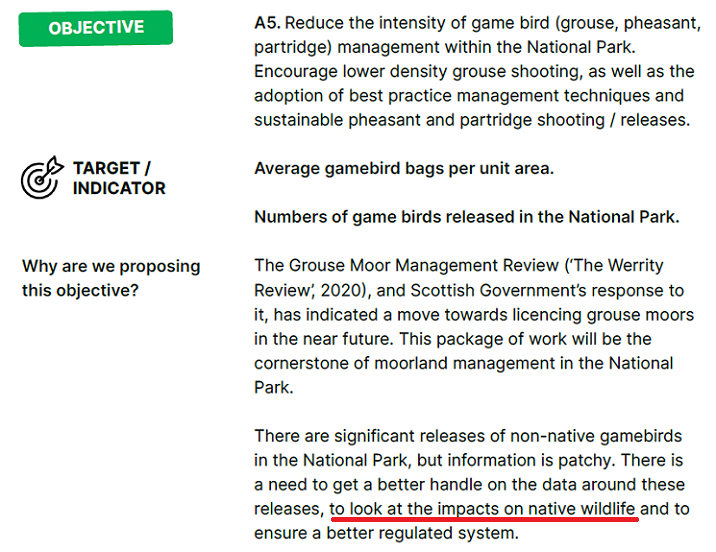
Raptor Persecution UK commented on this in an excellent blog at the end of September (see here) which mentions parkswatch. While from one perspective RPUK is right, given the landowning interests on the CNPA Board this objective would be a radical step forward for the National Park, looked at in cold blood the target is vague and unambitious and the objective as currently phrased will have no bite.
The revised objective in the CNPA’s new NPPP on species is just as vague:
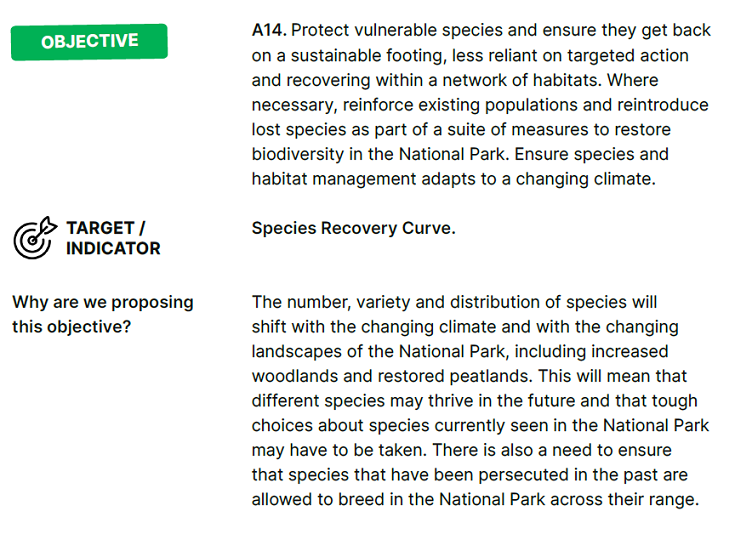
The current NPPP committed to eliminate the raptor persecution that has plagued the National Park within five years, i.e by now. That has totally failed. But instead of strengthening the objective, the CNPA is effectively proposing to water it down while extending it to “species that have been persecuted in the past” in a vague commitment to “allow” species to breed across their range. This is hopelessly weak: success could be claimed if sporting estates allowed predators to breed but then killed them immediately afterwards!
What should have been an opportunity to ramp up the protection for all predators is in danger of being lost completely.
What needs to happen
Instead of being host to fully functioning natural ecosystems, the web of life in all its glory, the Cairngorms National Park is home to a tangled web of damaging land-management practices. Most of these ultimately derive from how the land is being managed for sporting purposes. Plastic tree tubes are just one part of that, a consequence of a National Park high in deer and low in predators but which in turn cause further environmental damage,
While we need to reform the whole system, one way to force change is simply to ban certain damaging land-management practices. A ban on deer fencing and tree tubes, for example, might force forestry and conservation interests to start speaking out against how sporting estates are managing their land, instead of picking up the tab as they do at present.
The NPPP is an opportunity to take the sort of radical action the climate and environmental crises require. The new Minister for National Parks, the Green MSP Lorna Slater, should be encouraging the CNPA to do just that but it will help if the public pile on the pressure. One way to do so would be to respond to the NPPP consultation supporting a ban or alternatively you could pin a comment on the interactive map (see here) to one of the many places in the National Park blighted by plastic tree tubes.

A topical post, relevant questions asked as usual, however i became a little lost when reading the paragraphs on Ralia, forgive me if my interpretation is at fault.
I am very familiar with this stretch of road, but have not passed along it for over a year.
As a retired keeper of many years experience, i can assure you that the “miles of chicken wire fencing” have no relevance to the control of Stoats, either their numbers or movement. It is most likely to be in place to prevent the migrations of Rabbits, to and from the Woodlands over the road, it would serve a secondary purpose in forcing Pheasant and Partridge to flush over, instead of running out in front of traffic.
On another point, i do not believe that a reduction in game birds released, over a given area, would necessarily result in a relaxation of pressure against predators, it may be deemed even more essential.
I agree that certain larger grazing animals are the main inhibitors of re – generation, and numbers must be drastically reduced, rabbits are a more local problem, there are many area’s of good regeneration of Birch, Pine, and general scrub within the Newtonmore area that are not rabbit fenced.